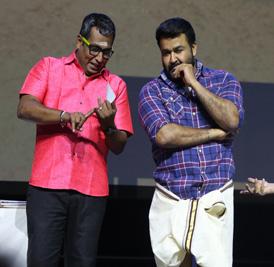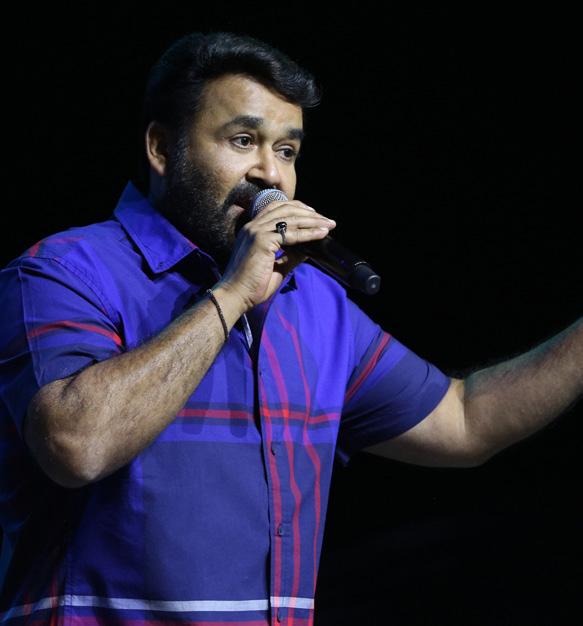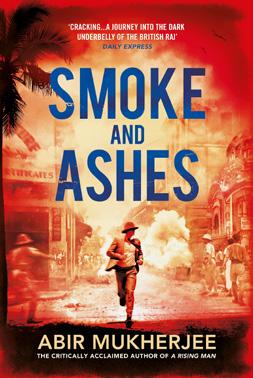
5 minute read
Mohanlal Mania
from 2018-06 Sydney (2)
by Indian Link
An earnest performance despite a few hiccups here and there
BY EMIE ROY
Cinema’s jack of all trades, master of many. That’s how one magazine described Mohanlal in 2004. Fourteen years later, the title still stands, and this was best illustrated by the superstar’s recent stage show in Sydney, Mohanlal Starnite, as part of his Australian tour to mark his 40 years in showbiz.
Even in a production that had more than a dozen other artists including some brilliant musicians, Lal pretty much stole the show. During the three-hour event, he graced the stage for more than 70% of the time, at times singing, at times dancing and at times doing something that is second nature to him – acting. It was interesting to watch the spectators, fixated as they took in one of the most sought after Indian actors performing ‘live’ in skits. The show opened some half an hour late to a packed audience at Quay Centre, Sydney Olympic Park. In the opening segment Mohanlal made a dramatic entry on the stage all by himself, conversing to the audience about his life and his evolution as an actor, and singing the song I believe in you, originally sung by the American country singer and songwriter Don Williams. It was exactly the spectacular beginning to the evening that the audience had hoped for.
The event was interspersed with testimonials in the form of videos from eminent directors of the Malayalam film industry that Mohanlal has worked with all these years. They were quite smartly used as fillers.
As the show progressed, a few amazing singers were showcased – MG Sreekumar, Preethi Warrier and the 12-year-old child prodigy Shreya Jayadeep that the crowd clearly adored.
Mohanlal has always been quite vocal about his love for music in real life, so it was not surprising that the show was heavily loaded with songs, with pretty much half of the artists singing, and Mohanlal himself crooning a few numbers, much to the delight of the audience.

Unfortunately, though, it ended up becoming a double edged sword for the actor. A lip-sync fail for one of the songs stirred up a fair bit of controversies. “We totally understand that Lal is not a singer, so it is fair enough that he uses the back track for one of the songs. But we never wanted to – nor were we expecting him to – sing so many songs in a signature show of his,” commented Priya, an audience member.
Around 2,000 people that witnessed the show were also a bit divided about his singing performance, especially when he sang songs from the ‘70s, probably because Mohanlal’s film songs from the ‘80s and ‘90s were what most people here grew up with.


Lal did a few dance numbers too, most of them in the soothing, semi-classical style unlike his more popular peppy onscreen numbers. Another male dancer, Arjun Lal, led the team in the more energetic ones. Boasting a huge local participation, the dances were beautiful though not resplendent. Stand-up comedian Suneesh Varanad cracked up the audience, and the two lead actresses Prayaga Martin and Meera Nandan made ample efforts to add value to the show. Overall, if your aim was to catch a glimpse of the legendary “Complete Actor” (as he is fondly called by his admirers) in action, this was the perfect opportunity to do so. “Unlike a lot of ‘superstar’ shows, this man was there in flesh and blood for more than threequarters of the time; performing in front of the audience, like a true workhorse. And it did compensate for the minor flaws in the larger scheme of things for sure,” said Mathew, aptly summing up the experience.

Its foundations already shaken by Jallianwala Bagh, the British Raj now faces a new type of freedom struggle – one utilising the country’s teeming millions as willing ‘martyrs’ to put pressure on the rulers while eroding their loyalists. With former imperial capital Calcutta a hub, can its hardpressed policemen tackle a case of serial murders, avert a massacre and ensure a royal visit is successful?
Captain Sam Wyndham of the city CID finds himself tasked with dealing with all three matters in Smoke and Ashes, the third installment of Abir Mukherjee’s thrilling and wellresearched historical crime series.


While either of the tasks would test any capable man, our hero must also try to rise above his secret, shameful, vice – liable to have adverse personal and professional consequences (as we learn in the tense, nightmarish first chapter).
Though Wyndham can count on Sergeant “Surrender-Not” (Surendranath’s pronounceable Anglicised version) Banerjee, his loyal aide now is hampered by his own problems, with the NonCooperation Movement causing bad blood between him and his family and friends, all on the other side.
While confrontation looms between the regime and the freedom fighters, spearheaded by the canny but principled lawyer Chittaranjan Das and his key aide, especially after the Congress volunteers are banned, the city is rocked by a series of brutal murders, including those of a British scientist and a Goan military hospital nurse. For not only do the corpses bear two gaping holes in their chests, their eyes have been gouged out too.
Wyndham and Banerjee are given the case, but Military Intelligence’s secretive and devious Section H, headed by the old adversary Major Dawson, soon take over
– though that doesn’t stop our duo from digging on.
– though that doesn’t stop our duo from

Matters meanwhile come to a head as the authorities schedule a trip by the visiting Prince of Wales to the restive city, while Section H now reveals the serial murders may have their roots in a series of military experiments, where poison gas was tested on some sepoy “volunteers”, and that a consignment of the gas has now gone missing.
Will Wyndham manage to overcome his secret weakness and the military intelligence operatives’ own agenda to solve the case? Will this also forestall a monumental disaster if the poison gas is in the hands of the suspected murderer?
We learn how all this pans out in the course of this riveting mystery, full of twists and turns till well into its denouement, where the Britain-based Mukherjee ably uses historical records (save in case of one rather high-stake standoff) to deliver an engaging, realistic backdrop to the action. And then, the author provides some incisive literary and historical flourishes. This can be the curious relationship between the setting and the principal protagonist, with Wyndham, wondering why he felt at home there, “that, in its own way, Calcutta was as flawed and dysfunctional as I was: a city built in the middle of a fetid Bengal swamp, populated by misfits all struggling to survive against the odds”.
Or the new politics of the freedom struggle – how Wyndham saw Mohandas Gandhi, a view that may have been of a maverick but would increasingly gain
“man in his little dhoti” had persuaded traction among his more understanding compatriots in how even the sight of a “man in his little dhoti” had persuaded millions, beyond the big cities’ “parlourroom revolutionaries” to “boycott British products, resign from government posts, and generally create a bloody nuisance”.
Mukherjee also can’t resist showing that the strategy resonated with the Bengalis. And then, there are the historical personages, say Das’ aide, “a young, bespectacled Bengali, with a moon face and neatly parted, prematurely thinning, black hair”, recently returned from England, where he had topped the Civil Service entrance examinations but declined to join the service, and returned to India to fight for independence. Sound familiar?
It is all this that keeps this book from being just another exotic murder mystery to serve as a vivid portrait of Indian history’s course at a crucial time.
Vikas Datta










